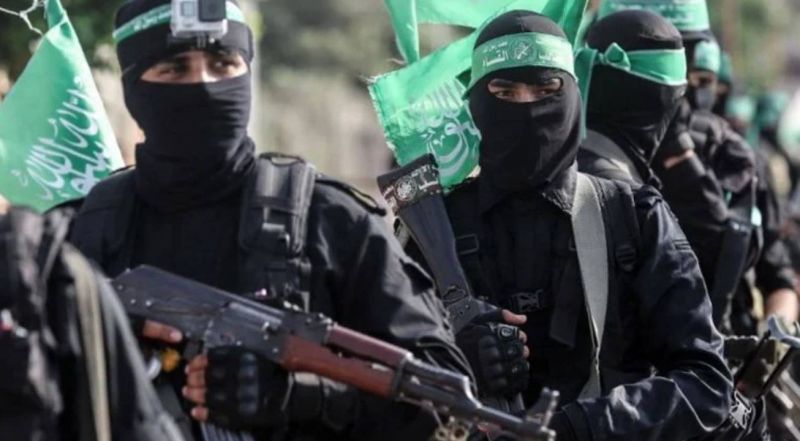
Fighters from the armed wing of Hamas in the streets of Gaza on July 20, 2017. (Credit: Saïd Khatib/AFP)
As Israeli infantry and armored tanks push deeper and deeper into the northern Gaza Strip, with air strikes continuing to pound the Palestinian coastal enclave, the prospect of a full-blown ground war looms.
Israeli Prime Minister Benjamin Netanyahu has promised to turn all places sheltering Hamas fighters into “ruined land.”
Hamas announced that it has “reserved a few surprises for the enemy,” according to Ali Barakeh, an exiled senior Hamas politician.
We took a closer look at Hamas’ military and strategic capacities:
Weapons and ammunition
Hamas has an arsenal of drones and around 30,000 rockets. It has fired 8,500 of these since Oct. 7, reducing the effectiveness of Israel’s Iron Dome interceptors.
According to Michel Goya, a military historian interviewed by Le Monde, Hamas also uses numerous armed booby-traps, such as improvised explosive devices (IEDs), a type of non-conventional weapon that can be activated in a variety of ways. The group also uses shells and mines.
Hamas is now manufacturing many of its own weapons, developing drones and unmanned underwater vehicles, engaging in cyberwarfare and is on the verge of switching from unguided rockets to drones and GPS-guided precision missiles, according to a 2021 study conducted by the Jerusalem Center for Public Affairs.
Hamas has said it now manufactures shoulder-fired “Mutabar-1” anti-aircraft missiles, which it claims can destroy Israeli helicopters, as well as “al-Yassin” anti-tank rockets, capable of piercing the armor of Merkava tanks, the technological flagship of Israel’s arsenal.
Training
Hamas has grown considerably stronger militarily since Israel’s first ground incursion during the 2008-2009 war. This is in part the result of its growing links with Iran’s Islamic Revolutionary Guard Corps (IRGC) and Hezbollah, particularly through the transfer of military expertise.
Today, Hamas’ military wing, the Ezzedine al-Qassam Brigades, is estimated to have between 15,000 and 40,000 combat-ready fighters.
This is an advantage over Israel, according to Israeli general Yitzhak Brik, who declared that “the army was not ready,” and warned in August of its growing inefficiency to win a possible war.
In Brik’s view, this has been due to the progressive neglect of infantrymen in favor of Israel’s air force. Israeli soldiers have not engaged in major urban combat since 2014 (in Gaza).
Tactics and techniques
Hamas’ immense comparative advantage over Israel lies in its knowledge of Gaza’s terrain. The 41-kilometer-long, densely populated urban zone presents major risks for the Israeli Army.
“There is no comparison,” said Barakeh last week in the Financial Times.
According to Goya, the tactics employed by Hamas consist of concealment techniques. Fighters could attack Israeli tanks from abandoned buildings from above, firing at the roofs of the armored vehicles, which are less protected than the front of the vehicles. They can also attack from basements, Goya said.
Hamas brags about having dug out an underground network, the “Gaza metro,” which consists of 500 kilometers of tunnels in which fighters can take shelter from bombs and surprise the enemy.
This gigantic underground network is also supplied with weapons and food in the event of an Israeli siege of the Gaza Strip, according to Hamas.
Hamas developed a communications network that enabled it to secure its telephone line with a conventional cable system, makes hacking virtually impossible.
Hamas is also said to have an alternative encrypted communications system for exchanging military information internally.
According to an anonymous Israeli official, one of the reasons Israel was unable to predict the Oct. 7 attack was that the intelligence services were tapping “the wrong lines.”
Strategy
“We prepared for an [Israeli] ground offensive even before we launched our attack,” Barakeh told the Financial Times.
Hamas took 239 hostages during its attack on Oct. 7 as a bargaining chip it intends to use in exchange for a cessation of hostilities or “the release of all prisoners held in the prisons of the Zionist occupier,” according to the group’s statement on Saturday.
Part of Hamas’ strategy is to exhaust Israel’s troops over time and the Israeli Army’s advance is likely to be very slow.Having bombed a large part of the Gaza Strip, rubble littersg the ground, blocking roads. Bulldozers are needed to clear the ground.
“The Israeli advance will probably be a few dozen meters per hour,” Goya told Le Monde. “It’s a matter of several weeks, if not months.”
Israel faces a new challenge: a reduction in its human resources. Some 360,000 reservists have been called up, necessitating an absence from their regular duties for an unspecified duration of time.
Should the conflict extend beyond two months, Israel’s functioning could be disrupted. This is particularly critical, given the possible emergence of new fronts along the Lebanese Israeli border and the West Bank, which would further burden thee Israeli Army.
This article was originally published in French in L'Orient-Le Jour. Translation by Sahar Ghoussoub.